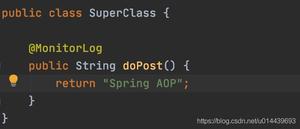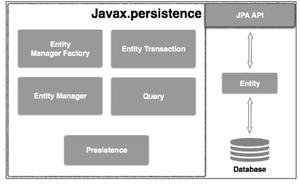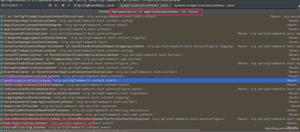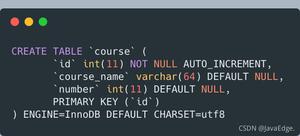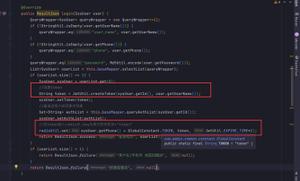Spring 3.0 注解注入详解
本文内容纲要:
- 同期最新- 热点专题
Spring 3.0 注解注入详解
2011-04-15 09:44 17ZOUGUO ITEYE博客 我要评论(1) 字号:T | T

AD:
一、各种注解方式
1.@Autowired注解(不推荐使用,建议使用@Resource)
@Autowired可以对成员变量、方法和构造函数进行标注,来完成自动装配的工作。@Autowired的标注位置不同,它们都会在Spring在初始化这个bean时,自动装配这个属性。要使@Autowired能够工作,还需要在配置文件中加入以下
Xml代码
<beanclass="org.springframework.beans.factory.annotation.AutowiredAnnotationBeanPostProcessor"/>
@Qualifier注解
@Autowired是根据类型进行自动装配的。例如,如果当Spring上下文中存在不止一个UserDao类型的bean时,就会抛出BeanCreationException异常;如果Spring上下文中不存在UserDao类型的bean,也会抛出BeanCreationException异常。我们可以使用@Qualifier配合@Autowired来解决这些问题。如下:
1). 可能存在多个UserDao实例
Java代码
- @Autowired
- @Qualifier("userServiceImpl")
- public IUserService userService;
或者
Java代码
- @Autowired
- publicvoid setUserDao(@Qualifier("userDao") UserDao userDao) {
- this.userDao = userDao;
- }
这样,Spring会找到id为userServiceImpl和userDao的bean进行装配。
2). 可能不存在UserDao实例
Java代码
@Autowired(required = false)
public IUserService userService;
@Resource注解
JSR-250标准注解,推荐使用它来代替Spring专有的@Autowired注解。@Resource的作用相当于@Autowired,只不过@Autowired按byType自动注入,而@Resource默认按byName自动注入罢了。@Resource有两个属性是比较重要的,分别是name和type,Spring将 @Resource注解的name属性解析为bean的名字,而type属性则解析为bean的类型。所以如果使用name属性,则使用byName的自动注入策略,而使用type属性时则使用byType自动注入策略。如果既不指定name也不指定type属性,这时将通过反射机制使用byName自动注入策略。要使@Autowired能够工作,还需要在配置文件中加入以下:
Xml代码
- <beanclass="org.springframework.context.annotation.CommonAnnotationBeanPostProcessor"/>
@Resource装配顺序:
a.如果同时指定了name和type,则从Spring上下文中找到唯一匹配的bean进行装配,找不到则抛出异常
b.如果指定了name,则从上下文中查找名称(id)匹配的bean进行装配,找不到则抛出异常
c.如果指定了type,则从上下文中找到类型匹配的唯一bean进行装配,找不到或者找到多个,都会抛出异常
d.如果既没有指定name,又没有指定type,则自动按照byName方式进行装配(见2);如果没有匹配,则回退为一个原始类型(UserDao)进行匹配,如果匹配则自动装配;
- @PostConstruct(JSR-250)注解
在方法上加上注解@PostConstruct,这个方法就会在Bean初始化之后被Spring容器执行(注:Bean初始化包括,实例化Bean,并装配Bean的属性(依赖注入))。它的一个典型的应用场景是,当你需要往Bean里注入一个其父类中定义的属性,而你又无法复写父类的属性或属性的setter方法时,如:
Java代码
- publicclass UserDaoImpl extends HibernateDaoSupport implements UserDao {
- private SessionFactory mySessionFacotry;
- @Resource
- publicvoid setMySessionFacotry(SessionFactory sessionFacotry)
- {
- this.mySessionFacotry = sessionFacotry;
- }
- @PostConstruct
- publicvoid injectSessionFactory()
- {
- super.setSessionFactory(mySessionFacotry);
- }
- }
这里通过@PostConstruct,为UserDaoImpl的父类里定义的一个sessionFactory私有属性,注入了我们自己定义的 sessionFactory(父类的setSessionFactory方法为final,不可复写),之后我们就可以通过调用 super.getSessionFactory()来访问该属性了。
- @PreDestroy(JSR-250)注解
在方法上加上注解@PreDestroy,这个方法就会在Bean初始化之后被Spring容器执行。其用法同@PostConstruct。和@PostConstruct 区别在于:@PostConstruct注释的方法将在类实例化后调用,而标注了 @PreDestroy 的方法将在类销毁之前调用。
- @Component注解 (不推荐使用)
只需要在对应的类上加上一个@Component注解,就将该类定义为一个Bean了。Spring还提供了更加细化的注解形式:@Repository、@Service、@Controller,它们分别对应存储层Bean,业务层Bean,和展示层Bean。目前版本(2.5)中,这些注解与@Component的语义是一样的,完全通用,在Spring以后的版本中可能会给它们追加更多的语义。所以,我们推荐使用@Repository、@Service、@Controller来替代@Component。
7.@Scope注解
在使用XML定义Bean时,我们可能还需要通过bean的scope属性来定义一个Bean的作用范围,我们同样可以通过@Scope注解来完成这项工作:
Java代码
- @Scope("session")
- @Component()
- publicclass UserSessionBean implements Serializable{
- ... ...
- }
二、配置启用注解(注意以下配置需要使用spring2.5的头文件,在spring3.0中不适用)
1.使用简化配置
Spring2.1添加了一个新的context的Schema命名空间,该命名空间对注释驱动、属性文件引入、加载期织入等功能提供了便捷的配置。我们知道注释本身是不会做任何事情的,它仅提供元数据信息。要使元数据信息真正起作用,必须让负责处理这些元数据的处理器工作起来。
AutowiredAnnotationBeanPostProcessor和CommonAnnotationBeanPostProcessor就是处理这些注释元数据的处理器。但是直接在Spring配置文件中定义这些Bean显得比较笨拙。Spring为我们提供了一种方便的注册这些BeanPostProcessor的方式,这就是,以下是spring的配置。
Xml代码
- <beansxmlns="http://www.springframework.org/schema/beans"xmlns:xsi="http://www.w3.org/2001/XMLSchema-instance"xmlns:context="http://www.springframework.org/schema/context"
- xsi:schemaLocation="http://www.springframework.org/schema/beans
- http://www.springframework.org/schema/beans/spring-beans-2.5.xsd
- http://www.springframework.org/schema/context
- http://www.springframework.org/schema/context/spring-context-2.5.xsd">
- context:annotation-config/
- beans>
将隐式地向Spring容器注册了
AutowiredAnnotationBeanPostProcessor 、
CommonAnnotationBeanPostProcessor 、
PersistenceAnnotationBeanPostProcessor
RequiredAnnotationBeanPostProcessor
这4个BeanPostProcessor。
2.使用让Bean定义注解工作起来
Xml代码
- <beansxmlns="http://www.springframework.org/schema/beans"xmlns:xsi="http://www.w3.org/2001/XMLSchema-instance"xmlns:context="http://www.springframework.org/schema/context"
- xsi:schemaLocation="http://www.springframework.org/schema/beans
- http://www.springframework.org/schema/beans/spring-beans-2.5.xsd
- http://www.springframework.org/schema/context
- http://www.springframework.org/schema/context/spring-context-2.5.xsd">
- context:component-scanbase-package="com.kedacom.ksoa"/
- beans>
这里,所有通过元素定义Bean的配置内容已经被移除,仅需要添加一行配置就解决所有问题了——Spring XML配置文件得到了极致的简化(当然配置元数据还是需要的,只不过以注释形式存在罢了)。的base-package属性指定了需要扫描的类包,类包及其递归子包中所有的类都会被处理。
还允许定义过滤器将基包下的某些类纳入或排除。Spring支持以下4种类型的过滤方式:
过滤器类型 | 表达式范例 | 说明
注解 | org.example.SomeAnnotation | 将所有使用SomeAnnotation注解的类过滤出来
类名指定 | org.example.SomeClass | 过滤指定的类
正则表达式 | com\.kedacom\.spring\.annotation\.web\..* | 通过正则表达式过滤一些类
AspectJ表达式 | org.example..*Service+ | 通过AspectJ表达式过滤一些类
以正则表达式为例,我列举一个应用实例:
Xml代码
- context:component-scanbase-package="com.casheen.spring.annotation"
- context:exclude-filtertype="regex"expression="com\\.casheen\\.spring\\.annotation\\.web\\..\*"/
- context:component-scan>
值得注意的是配置项不但启用了对类包进行扫描以实施注释驱动Bean定义的功能,同时还启用了注释驱动自动注入的功能(即还隐式地在内部注册了AutowiredAnnotationBeanPostProcessor和CommonAnnotationBeanPostProcessor),因此当使用后,就可以将移除了。
是不支持spring的@Transcation和EJB的Spring's @Transactional or EJB3's @TransactionAttribute annotation。用此配置可以达到目的。
- 使用@Scope来定义Bean的作用范围
在使用XML定义Bean时,我们可能还需要通过bean的scope属性来定义一个Bean的作用范围,我们同样可以通过@Scope注解来完成这项工作:
Java代码
- @Scope("session")
- @Component()
- publicclass UserSessionBean implements Serializable {
- ...
- }
【编辑推荐】
- Java EE进阶之Spring事务深入浅出
- Spring事务管理高级应用难点剖析
- Spring的Hibernate事务管理机制
- 简单介绍Spring事务管理
关于Spring的更多文章
- Spring整合DWR comet 实现无刷新 多人聊天
- Spring中接口注入的三种方式
- 开源框架spring详解-----AOP的深刻理解
- 图解Spring2.5.6中面向切面编程(AOP)及实现
- Spring自动装配之不能偷懒
Spring开源框架技术
更多>>
- 专访:Java框架SimpleFramework开发团队创
- Java MVC框架性能比较
- 开源框架spring详解-----AOP的深刻理解
- 三大框架Struts2+Spring2.5+Hibernate3.5的
- 走进Java框架SimpleFramework开发
同期最新
更多>>
为什么要使用集合框架?
学习Mockito框架
详解Consistent Hashing算法
Hibernate中cascade与inverse属性详解
分享Spring中Bean的4种依赖检查模式
每个程序员都应该知道的福利
有可能挑战Java优势的四种技术
Eclipse插件大全 挑选最牛的TOP30
IT界那些性感的让人尖叫的程序员
前端必备:jQuery 1.7.1API手册
FAQ:关于 DB2 数据服务器使用的常见问题
写代码如坐禅:你是哪一类程序员?
jQuery是如何工作的
是什么让程序员想死的心都有了?
安装SQL Server 2005实例环境图解(多图)
热点专题
更多>>

走进Java测试利器:JU
Erlang编程指南
JavaScript入门经典(第4版)
iPhone SDK编程入门经典:使用Object
SQl Server 2008内核剖析与故障排除
iPhone有效利用 十大iOS免费网管应用
本文内容总结:同期最新,热点专题,
原文链接:https://www.cnblogs.com/zhangliang0115/archive/2012/03/01/2374948.html
以上是 Spring 3.0 注解注入详解 的全部内容, 来源链接: utcz.com/z/296442.html


